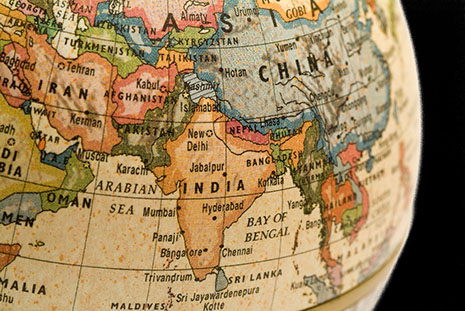CHINA’s push to expand its naval strength and presence in the Indian Ocean is prompting an apprehensive India to increase the size of its 171-ship navy by some ninety-four ships, including two aircraft carriers and at least three nuclear powered-submarines.
While China’s Indian Ocean naval strategy is attracting only limited mainstream media attention, it is exciting global interest among academics and in think-tanks. Beijing is seen to be playing a long game to assert its interests in the critical waterway linking the Middle East to East Asia and to mark its rise as a global power.
Last December, in a paper for the Centre for Independent Studies, John Lees argued that the resurgence of China and India was a recipe for rivalry “which could come to define the strategic landscape of Asia in the next few decades.” His view is widely shared and seems supported by rising Chinese–Indian naval competition.
At the Lowy Institute for International Policy, Ashley Townshend argued similarly: “Given the long-standing tensions over their disputed land border, mutual anxieties about being contained, and both states’ rapid expansion of blue-water naval capabilities, conditions appear ripe for Sino-Indian competition at sea.”
Although the issue is not mentioned in the Australian defence white paper, the size of Australia’s planned naval expansion – including twelve submarines, three air war destroyers, two heavy amphibious ships and twenty-four naval helicopters, as well as other acquisitions – suggests that Indian Ocean concerns were among influences that shaped that document.
Despite India’s worries of an overbearing Chinese competitor in what New Delhi likes to think of as an Indian lake, the Indian Ocean is not the focus of Beijing’s short-term naval strategy as it expands its already formidable 225,000-crew navy, which includes fifty-eight submarines, including eight to ten nuclear submarines, twenty-six destroyers and fifty-six frigates.
China’s immediate primary objective is to build a modern naval force capable of dominating what it calls “the first island chain” stretching from Japan to Taiwan and the Philippines. The aim of its ship and weapons acquisition programs is to restrict the activities of powerful US carrier battle groups and to be able, if necessary, to mount an invasion of Taiwan. Its second aim is to have a global blue-water naval force capable of operating into the “second island chain” which includes Guam, Indonesia and Australia. Hence its contentious declaration that the disputed South China Sea is a “core interest.”
The Indian Ocean strategy is China’s longer game, motivated partly by its desire to protect its sea lines of communications and partly by its desire to assert its rise as a global power. The strategy has been unfolding slowly, if inexorably, for many years.
More than fifteen years ago China declared, “We can no longer accept the Indian Ocean as only an ocean of the Indians.” Recently Shen Dingli, a professor at Fudan University, Shanghai, wrote that it was wrong for China to believe that it had no right to set up bases abroad. To stop other states from blocking China’s trade routes, he argued, China needed a blue-water navy and overseas military bases.
Last year ,Harsh V. Plant of King’s College, London, wrote that China’s new declared naval strategy of “far sea defence” was aimed at giving Beijing the ability to project power in key oceanic areas, “including and most significantly the Indian Ocean.” Hence, what has become known as China’s “string of pearls” strategy in the Indian Ocean – through which Beijing aims to gain naval access rights in Pakistan, Burma, Bangladesh, the Maldives and Sri Lanka by participating in the development of commercial port facilities and possibly intelligence-collection capabilities in those countries.
The significance of that strategy is disputed. Plant argues it has “significantly expanded China’s strategic depth in India’s backyard” but David Brewster of the Australian National University argues that it “will be a long time before any such capabilities come to fruition.”
Yet India is clearly spooked by the strategy – hardly surprising given its history of conflict with China and the massive superiority of the Chinese navy. Currently some thirty-six of India’s planned ninety-four new naval ships are under construction. But despite its plans to increase the number of principal combatant ships by some 25 per cent by 2015, India will still have a navy only a quarter the size of China’s, according to Ashley Townshend.
This is one reason why India has been moving to strengthen its ties with the United States, which still possesses by far the world’s mightiest navy. With 330,000 personnel (plus 101,000 reservists) and 253 battleships including eleven aircraft carriers, fourteen ballistic missile submarines, fifty-three nuclear attack submarines, four guided missile submarines and 100 surface combatants, the US navy is and will remain a massive deterrent force.
It is not a force China is any position, or hurry, to challenge. Moreover, as Townshend notes, India’s partnership with the United States “will for the foreseeable future ensure that the overall maritime balance of power remains tilted in India’s favor.” Nevertheless, the United States has reacted uneasily to the Chinese expansion, although it is widely agreed that Beijing’s naval capabilities are still limited. The chairman of the US Joint Chiefs of Staff, Admiral Mike Mullen, said recently: “I have moved from being curious to being genuinely concerned.”
India has also moved to develop security relationships in the region, especially with Mauritius in the south-west Indian Ocean. As David Brewster has noted, “Mauritian political leaders have publicly indicated on several occasions that India would be permitted to establish naval facilities on Mauritius if it so wished and there are claims that India already operates a signals intelligence station.”
Despite his concerns about the Chinese strategy, Plant concludes that it “remains a bit far-fetched” that China aspires to naval domination of the Indian Ocean. But he says China does wish to play a greater role in the region, protect and advance its interests and to counter India. “[T]he steps that China is taking… are generating apprehensions in Indian strategic circles, thereby engendering a classic security dilemma between the two Asian giants,” Plant writes. Clearly a great game is being joined. •




